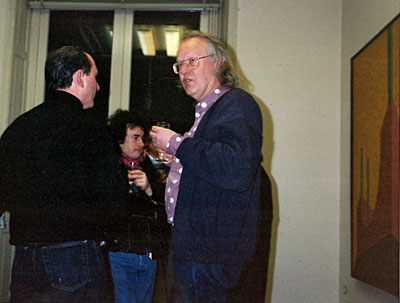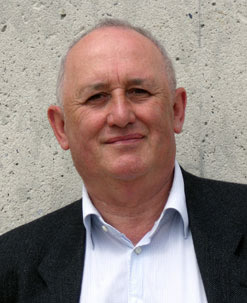Like every other child I started to draw and paint as soon as I was able to hold brush and pencil. Contrary to others, I never lost that interest. Already as a child, art, especially modern art, fascinated me. At the age of 13 I already had read everything about modern architecture the public library of my hometown Delmenhorst could provide me with. Unusual perhaps for a working class kid of the 60s in a secondary school. Nevertheless it took me a long time to be able to finally study arts. In 1981 an adult education system then possible in Germany enabled me to enter the “Hochschule für Gestaltung” “College for Creative Works” in Bremen, which, during my studies, became the “Akademie für Künste” “Academy for Arts”).
Painting and drawing, also the interaction of these two poles, are the medium of my work, the topics are architecture and sculpture as well as the combination of these two.
To simplify it: themes are form, colour and structure. Now, art in itself has many layers and levels of meaning. Nothing is only what it seems to be. Naturally my art is also a statement of modernism, aesthetics, beauty and power. Of course what one does tells something about the artist. I do not show architecture that does or should exist. My paintings are and are not representational, as the topic of painting is always the occupation with colour as such. Looking at my paintings, one should try to blend out the representation for a change and be effected by form and colour only. Radiation and emotionality are just as important parts as the intelligent development and representation of the piece. The search for forms, colours and structures are topics just like other possible contents, thus what seems to be a representation loses its definition and gets integrated into basically unrepresentative painting. Nevertheless those paintings are representative, too, naturally, they have a very clear formal language, which has a purpose. Art for me is not there to be pretty, pleasant or to spread happiness. Art has to be intensive, uncomfortable, and even exude an irritating charm.
Quote by Hajo Antpöhler (1): “Schneider does not want to deliver paintings that glorify one-sidedly, and no paintings which are too obviously criticizing. He does not want to evaluate the frame of the world he paints simply after being good or bad, black or white. The architecture of power and intimidation has its fascinating aesthetic. But the fascination is bound to what belittles us, to the viciousness of power.”
“Schneider’s paintings are ambivalent in purpose and effect. They want to turn the beholder into a sceptic, who does not smooth the conflicts but instead faces them in a mature way.”
Quote by Barbara Alms (2): “Siegmund Schneider gets inspired accordingly even by toys and building blocks. His paintings open up an artificial world of pictures, obsessively presented, a narrow choice of motives without the possibility of avoidance. Gigantically oversized architectural parts tower into a synthetically illuminated sky, bottomless, of instable construction. Here there are no people. Here there are no decorations, no openings in the stone, no doors nor windows.”
“In spite of the simplicity of the forms and surfaces: no trace of tranquillity. On the contrary: the paintings transmit a strong disquietude. By close inspection it is clear: What seems to be designed as space, as a three dimensionality, transforms itself disturbingly into surface, i.e. the space destroys itself into the surface. It is a highly dangerous, depressingly calculated game between construction and its deconstruction. “
-
Hajo Antpöhler † was director of the “Haus am Wasser” – gallery in Bremen-Vegesack
-
Barbara Alms was head of the “Städtische Galerie” (City Gallery) “Haus Coburg” in Delmenhorst
-
A propos de moi
Comme probablement chaque enfant j'ai aussi commencé à dessiner et peindre dès que j'étais capable de tenir crayon et pinceau. Au contraire d'autres je n'ai jamais perdu cette intérêt. Depuis mon enfance je m'intéresse déjà pour les arts, spécialement les arts modernes. A l'âge de 13 ans j'avais déjà lu tous ce que la bibliothèque publique de ma ville maternelle, Delmenhorst, a pu me fournir. Un peu inhabituel pour un enfant de la classe ouvrière qui fréquenté une école secondaire dans les années soixante. Néanmoins, ça m'a prenne encore du temps avent que je pu étudier l'art. A travers d'une éducation de deuxième chance j'avais l'opportunité en 1981 d'étudier l'art à l'Académie des Réalisations Artistiques à Bremen, qui a changé pendant mes études en l'Académie des Beaux-Arts.
La peinture et le dessin, aussi l'intersection entre ces pôles, sont les médiums de mon travail, cependant, ses sujets sont l'architecture et la sculpture et la connexion entre les deux sujets.
On peut aussi le simplifier : sujets sont forme, couleur et structure. Maintenant l'art a beaucoup des facettes et significations divers, si elle est de qualité. Rien n'est seulement ce que donne l'apparence. Naturellement mon art est aussi uns expression par rapport à la Moderne, à l'esthétique, à la beauté et au pouvoir. Bien entendu, qu'en fait parle aussi sur le créateur de l'œuvre. Je ne montre pas un architecture qui existe ou pouvait exister. Mes tableaux sont objet et ne sont pas objet, parce que le sujet de la peinture est toujours l'occupation avec la couleur elle-même. En contemplation de mes images on devrait éclipser le figuratif et laisser agir la couleur et la forme. Rayonnement et émotionalité sont des ingrédients aussi importants dans l'art de qualité que trouver et créer une image dans une manière intelligente. La recherche des formes, des couleurs et des structures sont aussi des sujets comme d'autres expressions éventuelles, à cause de ça le soi-disant figuratif perd sa clairette et est intégré dans l'abstrait. Néanmoins les images sont naturellement figuratives, ont un langage clair et jouissant. L'art doit être intensive, avoir un rayonnement, être inconfortable et provoquer l'irritation.
Citation Hajo Antpöhler : «Schneider ne veut pas livrer des tableaux qui uniquement, glorifie et pas des tableaux qui ont trop clairement le but de critiquer. Il ne veut pas que l’extrait du monde qu’il paient si simple, si simplifiant, juger par bon et mauvais, noir et blanc. L’architecture du pouvoir et de l’intimidation a son esthétique fascinant. Mais la fascination est liée à ce que nous abaisse, à l’infamie du pouvoir. Les tableaux de Schneider sont en intention et en effet ambivalent, ont un double sens. Ils veulent transformer l’observateur en sceptique, qui ne lisse pas les contradictions, mais les confronte en tant qu’individu mature. «
Citation Barbara Alms : « Siegmund Schneider se laisse aussi inspirer par des jouets et des jeux de construction. C’est un monde d’images artificielles. Ses tableaux ouvrent, exposer d’une manière obsessive, un choix étroite de motif, sans possibilité d’évitation. Des parts d’architecture augmentée gigantesquement s’imposent dans un ciel illuminé artificiellement, sans fond, d’une construction instable. Ici il n’y a pas des êtres humains. Ici il n’y a pas des bijoux, pas d’ouvertures dans la pierre, ni portes ni fenêtres.
Malgré la simplicité des formes et surfaces donc : pas une trace de calme. Au contraire : les tableaux transmettent une grande insécurité. Car à l’observation minutieux : ce que semble être espace, trois-dimensionnalité, change subitement en pleine surface, a veut dire l’espace se détruit en pleine surface. C’est un jeu très explosif, sombrement calculé, entre la construction et sa destruction. »
|



